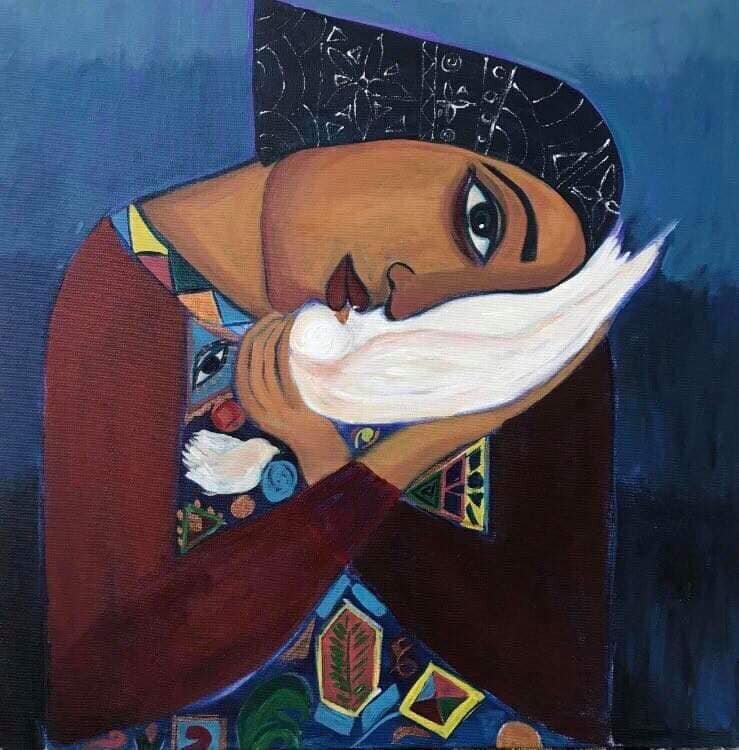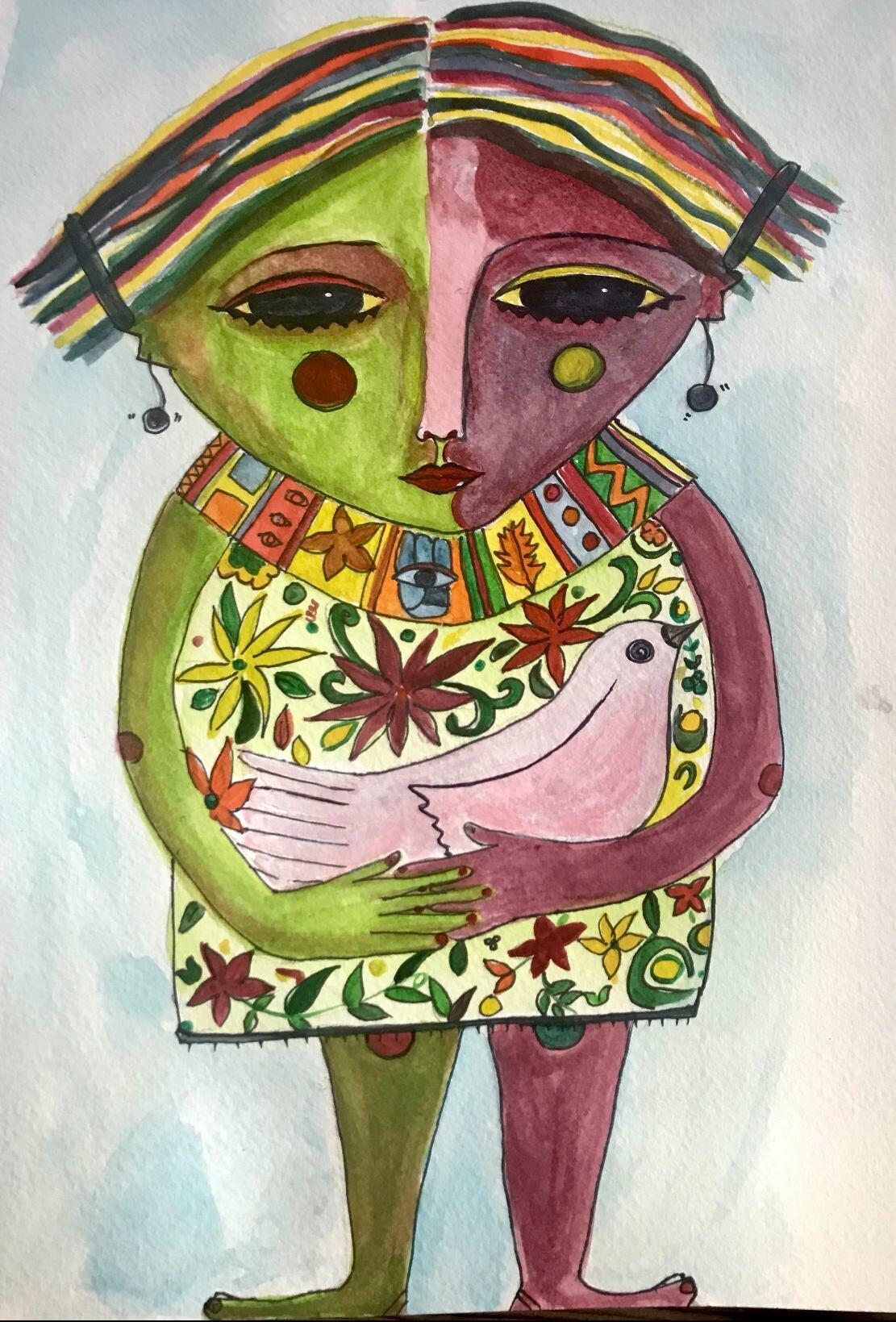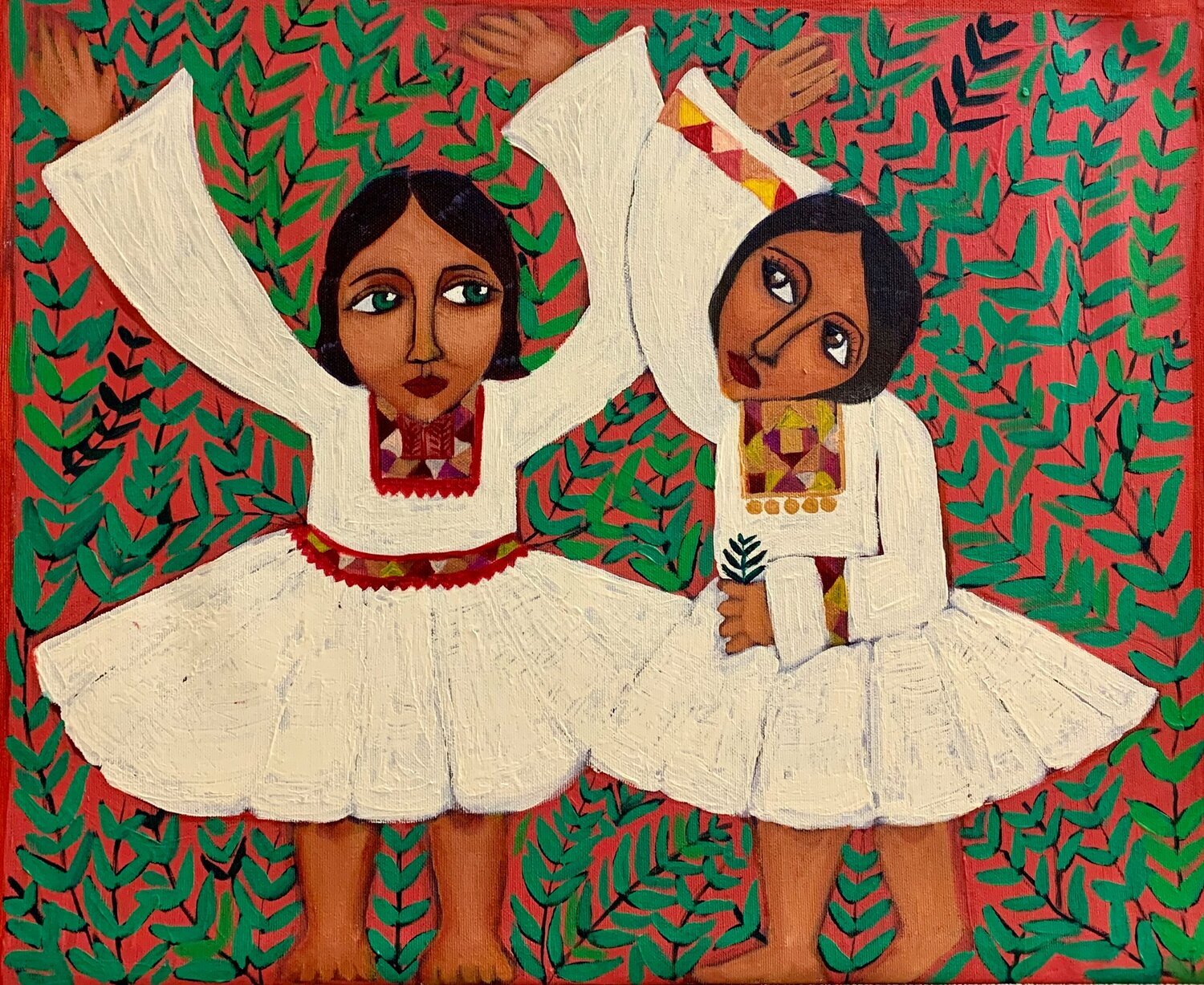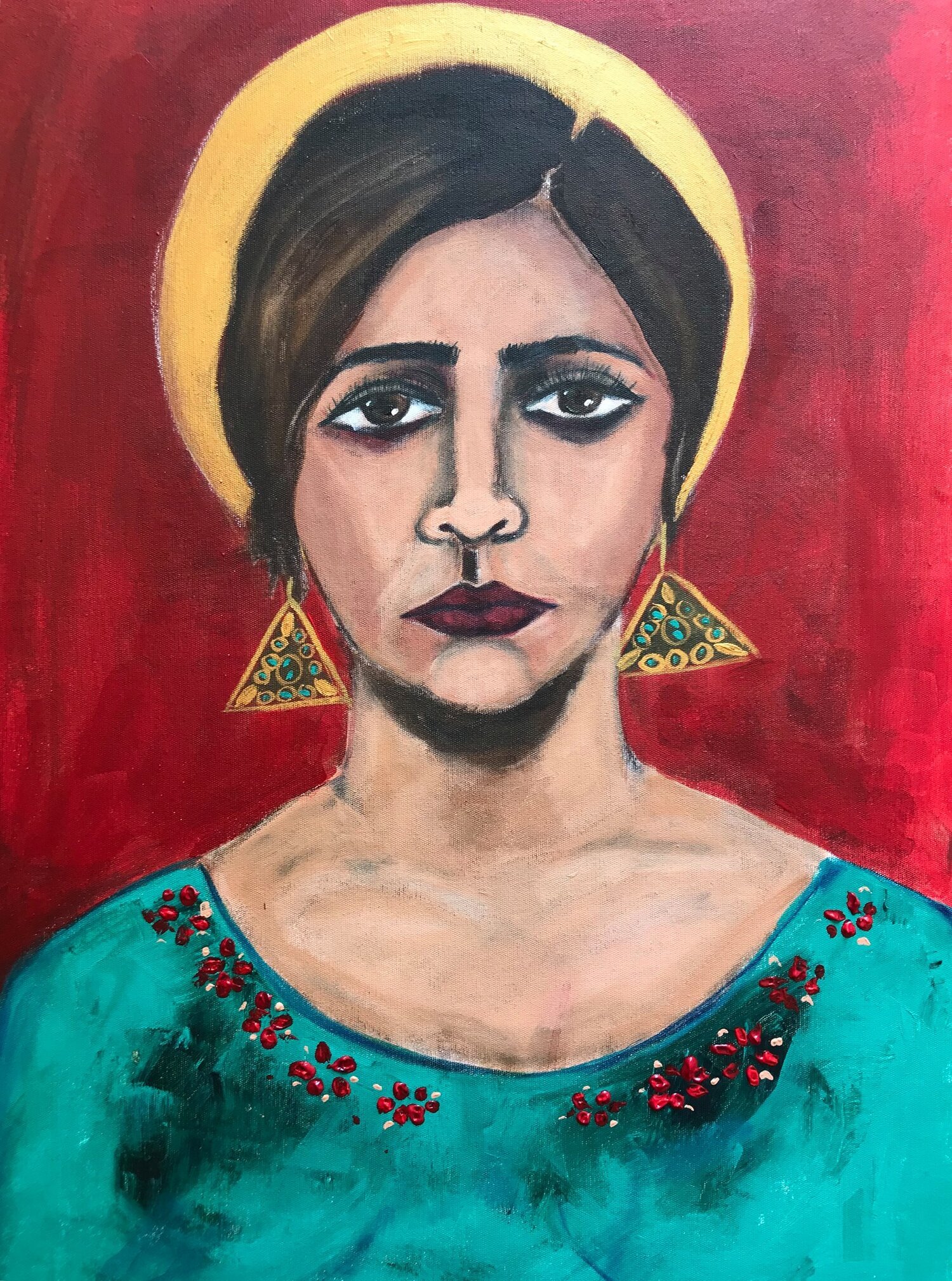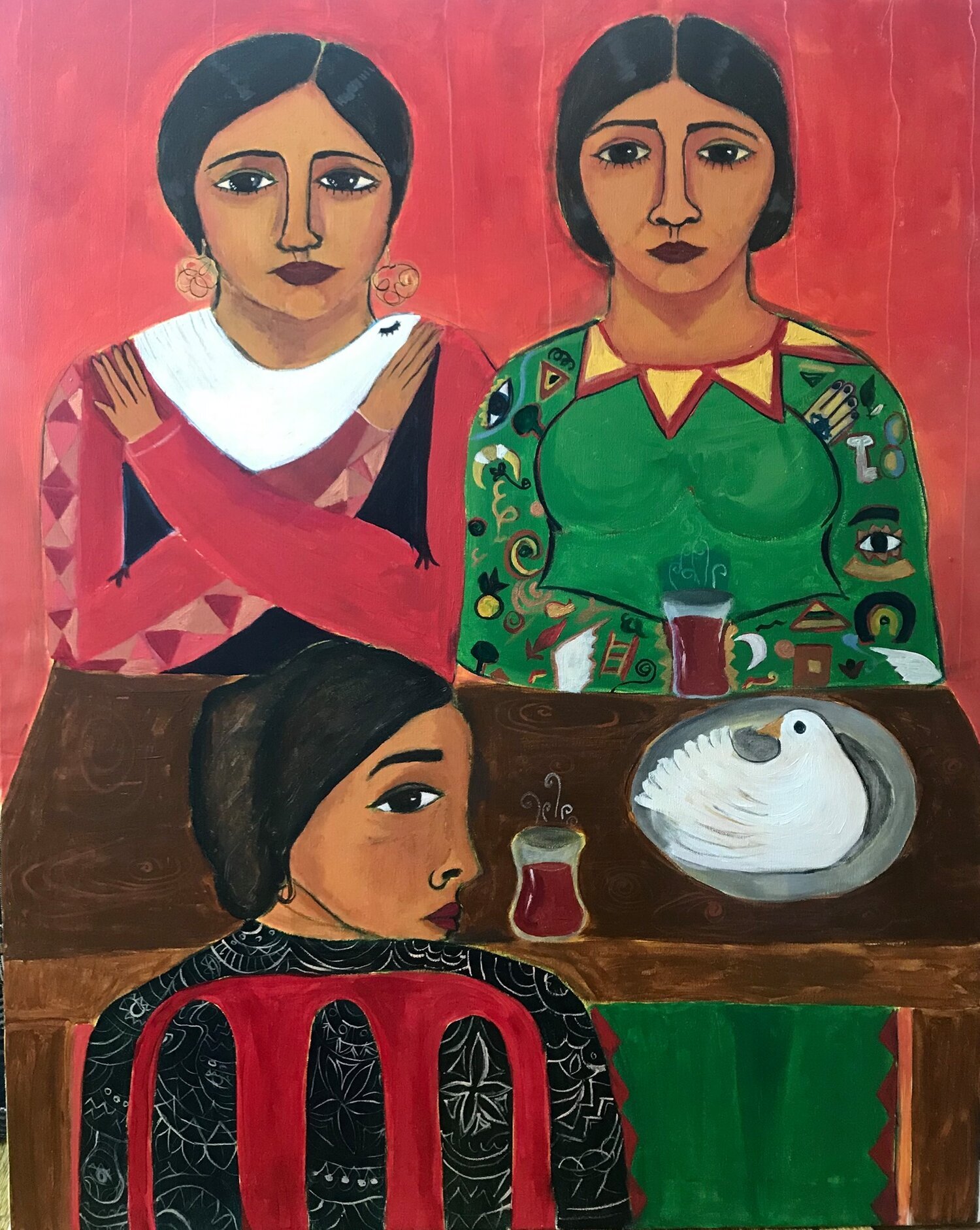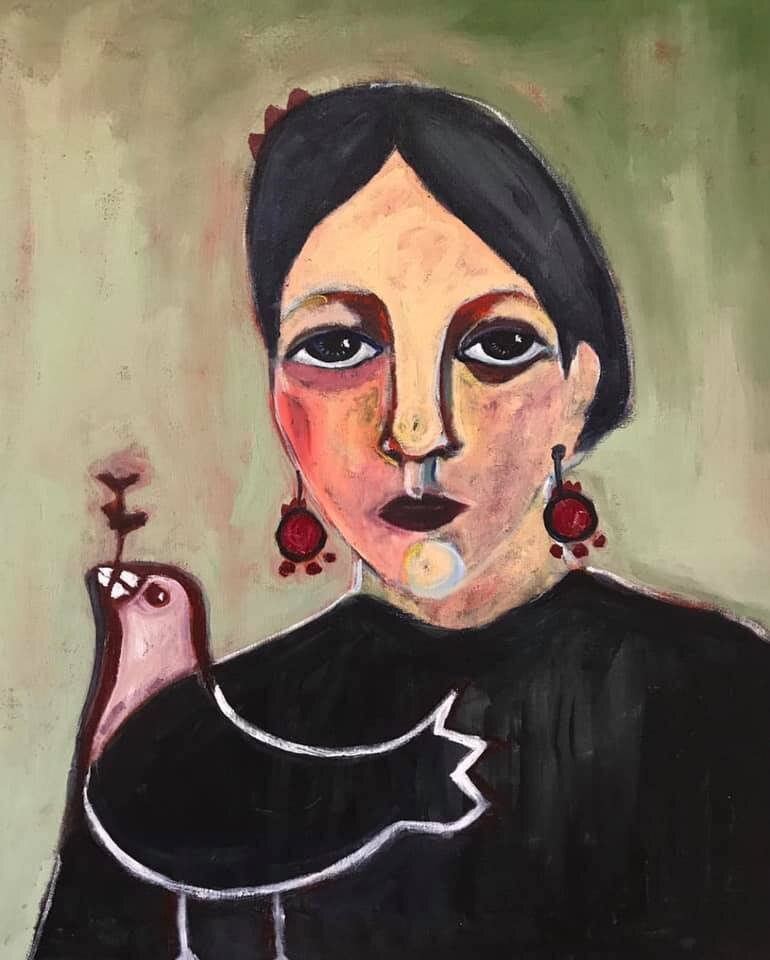An interview with refugee artist Malak Mattar: when paintings have more freedom of movement than people
Credit: We Are Not Numbers
Meet Malak Mattar, a 20-year-old artist and Palestine refugee from the Gaza Strip. While Malak grew up Gaza, her family, like a majority of residents, are refugees from north or east of the Strip’s current confines. Her father’s side is from Al Jorah, a village by the sea in what is now known as Ashkelon, where her grandparents were once fishermen. Her mother’s side hailed from Batani al Sharqi, a coastal village in the south of Palestine, where they were farmers. Forced to flee during the Nakba, her family arrived in Gaza in 1948 and have been refugees there ever since.
Today, Malak is known for her Picasso-like expressionist faces and abstract designs, painted largely in response to and a way to cope during and following the 51-day Israeli military assault on the Gaza Strip in 2014. Forced to stay inside and fearing for her own safety and that of her family and friends, she started to paint as an emotional release of the fear, anxiety, and terror she felt.
What was originally a form of coping and self-expression became her passion and livelihood, and one that has been appreciated by people far beyond the borders of the Gaza Strip. Since her first watercolor, she has produced hundreds of paintings, which have earned her international recognition, with her paintings being featured in Jerusalem, Spain, Turkey, Costa Rica, India, and the United States.
Malak visited the United States for the first time in August 2019 and shared her art and her ever-evolving story with the UNRWA USA team, answering questions on what drew her to art as a source of therapy, income, and cathartic release, the opportunities she has gained through her art, what she hopes to achieve in the future, and the role UNRWA played in her journey thus far. She’s back in the United States for a January 2020 speaking tour, including speaking engagements at Merrimack College, Smith College, Yale, Southern Connecticut State University, Manhattan College, Drew University, and DC’s Musem of the Palestinian People; before seeing her and her latest work, get to know the young woman behind the abstract portraits that have captivated people from all over the world.
Source: American Herald Tribune
[UNRWA USA]:Share the role of UNRWA in your life. Specifically, can you tell us about your experience in UNRWA schools?
[MALAK]: From first through ninth grade, I attended UNRWA schools. I studied in Al Shati (Beach) School in Gaza but moved around depending on which schools were offering different shifts — morning or afternoon. My teachers and education helped me excel academically, and after years of hard work, I was ranked second across all 30,000 Palestinian students in the tawjihi (matriculation) exams and first among all the students in the Gaza Strip.
[UNRWA USA]:What were your favorite subjects in school or some of the classes and teachers that stand out in your memory?
My favorite classes were math and languages. English was always the most difficult for me, but my teachers were so good that they made it enjoyable and ultimately one of my favorite and most useful classes.
But the most influential class in my artistic journey was, oddly enough, science class. In fact, the first art material I ever received and used were watercolors that I was given as an award from my school when I got full marks on my science exam.
I always saw science as art, in itself, as we were essentially painting and illustrating the world around us. For homework, we’d be asked to draw the human body or cell structures. But for me, these assignments were a joy. I was passionate about perfecting the shapes, lines, and colors. I worked hard and remember my teacher showing off my work to my classmates. When we had challenging exams, our teachers would motivate us by rewarding those who received full marks.
In sixth grade, I was one of those students who was rewarded, and while other students received a set of color pencils, I received watercolors. I put that watercolor set on a shelf in my home along with my other gifts and awards from school, it wasn’t until years later in 2014 that I would use them.
[UNRWA USA]:What drew you to start painting, if you can kindly ignore the pun?
[MALAK]: In 2014, I remember looking at the shelf with all the art supplies I had accumulated and told myself that I was going to do something with all these tools. The atmosphere was tense, and we were all afraid, but in the face of this, I remember pulling out a blank paper and starting to sketch and paint.
The feelings I had during the last war drew me to paint and sketch to escape the fear of death. I can still feel the feeling that I felt when I did my first drawing; I'll never sell that drawing — not for any price.
During the war, no one went outside, but everyone had social media. I created an account so I could share my drawings on Facebook and Instagram. Painting opened up a world of self-expression, and social media opened up my art to the world. People started messaging me not only in Arabic, but in English. I was excited because this meant people on the outside were paying attention to what was happening in Gaza. A year after that I decided to have a solo exhibition with 16 of my original pieces on canvas with acrylic. The Spanish, French, and English press reached out to me, and by the time I was 14, I was starting to sell my art to buyers across the world. In just four years, my art has made it to more than 60 exhibitions around the world.
Credit: Maha Selim; Source: Malak Mattar, Facebook
[UNRWA USA]:In the face of the Israeli blockade, it’s incredible to note that while you and other residents of Gaza were unable to physically leave, your paintings were, exposing the world to your story and reality. In the face of this bleak reality with limited freedom of movement what and/or who gave you hope?
Thanks to UNRWA, I was able to draw my first watercolor painting. My UNRWA teachers remain some of the most supportive influences in my life. My teachers comment on my posts on Facebook, encouraging me and complimenting my artwork. Their encouragement during the 2014 military assault represented a turning point in my life. They believed in me and made me feel special, smart, and talented. Then and now, I feel connected to them. My mom was an UNRWA English teacher, and she, of course, is one of my biggest fans.
[UNRWA USA]: Since 2014, can you share your inspiration for your art? What images and messages are you trying to share with the world?
[MALAK]: I draw my inspiration from everything around me. Palestine, my city, Gaza, my family, people I meet, and everything — the good and the bad — that I face in my life.
I want to share the injustices that my people go through, especially their lack of human rights. But also, I want to show the beauty and the strength of my people as well and the passion we Palestinians have despite the struggles we go through in Palestine and in the diaspora.
[UNRWA USA]: You’ve become known for your portraits of women. Beyond self-portraits, or those that show homage to female artists like Frieda Kahlo, are these illustrations based off women in your life or do you draw inspiration from your imagination?
[MALAK]: Most of the women that I draw are women that I know. They are from Gaza or they are friends or roommates. Even if it’s unintentional, my portraits end up resembling people I know. I grew up in a conservative and masculine society so I have witnessed the inequality between the two genders. I feel the struggle that women have to face, from housework, to marriage, to education, to everything. Society remains critical, so part of my mission is to paint the women I know — and those I do not know — and show their struggles in my paintings. Funnily enough [laughs], I try to paint men, but every time I do, they turn into women.
[UNRWA USA]:You are often compared to Picasso and Matisse. In what way do you draw inspiration from these artists or other artists as you’ve developed your own style, and how has your style changed over the years?
[MALAK]: I was so inspired by Picasso that in the beginning of my art journey I tried to paint like him. I can also relate to the pain that Frida Kahlo paints. But I decided to go beyond this and find my own style, which was challenging at a young age, and I learned largely from watching YouTube videos. I don’t have any formal art education. I spoke to other people and artists in Gaza to get more guidance. My uncle is a university professor in art and literature, and though he currently lives in Canada, he was once an artist in Gaza and his abstract art inspires me. He has always helped me with my technique, sketching, and new ideas. After traveling more, I also was able to draw inspiration from my trips. But most importantly, I draw inspiration from my surroundings. That is what mattered then when I first started painting and what matters to me now.
Malak’s pieces, ranging from watercolor to acrylics
[UNRWA USA]:Though travel allowed you to gain exposure and inspiration for your art, most people in Gaza have never left.How did growing up in Gaza, especially as a refugee, affect your art? In terms of style and content?
Malak’s favorite piece “Galaxy,” pictured on a publication entitled “We are not Numbers”
[MALAK]: My life experience in Gaza has shaped my style and my approach to art. Growing up in Gaza has made me more aware of how our world functions and the tragedies beyond that. If I grew up elsewhere, maybe my paintings would not be sad.
[UNRWA USA]:What considerations did you have to consider as a young, female refugee from Gaza that artists from other parts of the world may not have to think about?
Like most young people, I have dreams, but I’m also lucky to be able to pursue them. My first dream was to have a solo exhibition. But lots of people criticized me and didn’t believe in me when I said this. Gaza is like any other country where male artists are valued over women, so many people didn’t see my potential. My family and my teachers, however, were always supportive, but school always came first. Though my mom paid for my expensive acrylics, in the end, school was always the priority because it allowed me the most opportunities in the future.
I was exposed to media as a 14-year-old and had a lot of press, which was hard being a woman in a conservative society. I wasn’t wearing a hijab then because I was young, but I also faced lots of bullying and criticism for that. People were very focused on how I was presenting as a ‘Muslim girl,’ which put lots of pressure on me and my family. So my parents and I felt like I needed to wear a scarf. I was speaking up about things that were unfair and inequality between men and women and being forced to do things that I don’t want to do so that my art can take the focus. I still continue to struggle with this inequality, but I make sure I’m covered when I’m on the camera.
[UNRWA USA]: Which of your art pieces are you most proud of?
[MALAK]: I am proud of my Galaxy painting that has been a cover for a film that I was apart of (Dark Blue). It was filmed in Gaza and shown in many European countries as well. It has been published as the cover of the book “We are not Numbers,” along with 15 other paintings of mine.
[UNRWA USA]: What are you currently studying in Turkey and what are your academic hopes?
[MALAK]: I am studying political science and international relations at Istanbul Aydin University. I have a scholarship that covers my tuition fees, but I am working hard to make a living off my artwork. My plans are to pursue a Masters in Fine Arts in the United States and to have more exhibitions in the future.
Malak speaking at the Jerusalem Fund in Washington, DC in 2019
[UNRWA USA]: You’ve now traveled in the US and met many people and seen many cities. What stands out, and what message would you like to share with Americans that didn’t get the opportunity to meet you in person?
[MALAK]: I have mixed feelings when it comes to the US. I traveled to 7 countries this year, and the US was one of my favorites. I went to Washington, DC, New York, and Connecticut. The people were so so friendly — nowhere else were people as friendly! I was shocked by how simple everything was, unlike Gaza, and how easily you can have conversations with strangers. I did find some parts of the US stressful — DC and New York were a bit overwhelming and intense, especially given politics now.
My message to the US is that I'm willing to fight for my humanity and the humanity of all people — especially refugees. Even in Turkey, you are judged based on where you are from. But I'm tired of this elitism. What we all share is humanity, and that is the most important thing. What I want to share with the US and the world is that we are all humans, and the noble thing we need to do is to feel for each other. I will help you regardless of where you are from, and I will do so because you are human and because you are vulnerable; can you do the same? I often feel judged because of my identification or my travel documents or the color of my skin. Even in Gaza, I’m seen as a refugee, but it is my wish to the world that there is no racism, that everyone can travel freely, and that we are all treated equally as human beings.
Continue to follow UNRWA USA on social media for quotes, interviews, and live content from Malak while she is stateside in January 2020.





